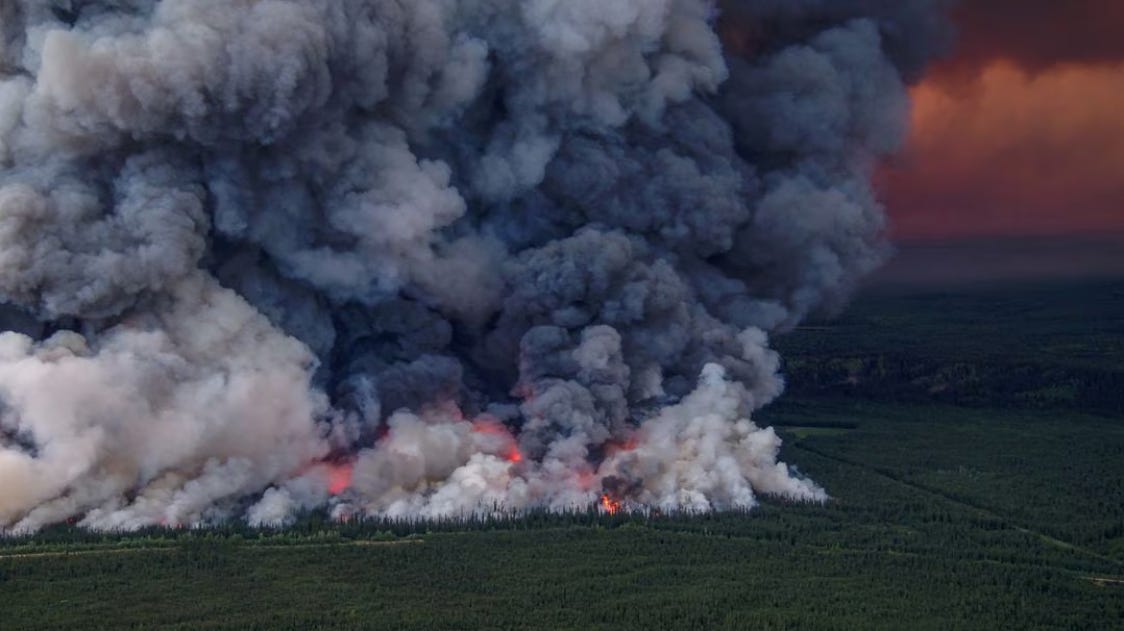There’s Something in the Air
Oh, No Worries, That’s Just Canada Burning

A few days ago, I took a three-mile walk with a good friend in Delaware Park, Buffalo, NY. Shortly after a week of record heat not seen here even in late summer, the weather had cooled to normal, with highs in the low 70s, not low 90s. It was a lovely day, although I noticed a haze veiled what should have been a clear blue sky. When Mary and I sat at a picnic bench to chat, I received an alert on my phone that raging fires in Canada were hazing the skies of NYC, and causing air quality alerts from Minnesota to Massachusetts.
The next morning I awoke to the sweetness of lilacs Mary had picked on our walk, but as my coffee kicked in, I became aware of a different aroma. When I dragged the garbage can back from the curb, I confirmed it was smoke and shut my windows. The air quality index hit a gritty 176 on Tuesday at my last check. I stayed in.
I have experienced poor air quality before. In the 1970s, living in Cincinnati, Ohio, the air quality index, a measure of health threatening air pollution, was part of the daily weather report. With heavy industry there including Proctor & Gamble and GM plants, the city’s location in the basin of seven tall, steep hills was prone to thermal inversions, trapping the grim smog. Index counts over 200 weren’t unusual during the summer. There were days when the pollution settled at street level, the fog thick enough to obscure the view of my neighbor’s houses across the street. I remember trying to ride my bicycle in those conditions and coming home gasping for air, in spite of having healthy, pink, sixteen-year-young lungs.

I was light-headed much of the day, pondering the smoke, unsure if it was the smoke itself or the stress of considering wildfires are out of control across the entire country of Canada. My neighbors to the north have been on fire for over a month now, and like Buffalo, setting records for extreme heat. The fires started in the west, the province of Alberta, and now dot much of the country. As of June 6, 413 fires blazed, with 249 deemed out of control. An astonishing 3.3 million hectares have burned (over eight million acres), since the beginning of the year, thirteen times the 10-year average, and more 120,000 people have been forced from their homes.

Canada has been enduring a heat dome which is similar to the thermal inversions I experienced in Cincinnati, but far more massive in scale, caused by the atmosphere trapping hotter than ever ocean air, as measured since 1981 by the US National Oceanic and Atmospheric Administration (NOAA) with buoys and satellites. The oceans, acting as a carbon sink for burned fossil fuels, have been heating up. In fact, the oceans have absorbed nearly 90% of the additional heat in the atmosphere we have created by burning oil and coal. If they hadn’t the air temperature would be dozens of degrees warmer. I wouldn’t be able to write this article, and you wouldn’t be able to read it. However, there is a price for heating the oceans. Bleached coral reefs, reduced oxygen, dying marine life, and the destruction of livelihoods for the poor and indigenous dependent on fishing, are some of the results.
Since the industrial revolution, we’ve pumped nearly 60 billion tons of greenhouse gasses into the atmosphere, half of it in the last 50 years. This year’s annual increase of CO2 levels is one of the largest on record.
High pressure creates a heat dome, locking in and pushing hot air down. Hotter than normal air from the ocean worsens the effect. The trapped hot air is compressed, causing it to get hotter and hotter, drying out the landscape and creating perfect conditions for fire. For western Canada, this is a one-in-1,000-year event created by #ClimateChange.
Last year, ocean heat absorption was equal to a shocking five Hiroshima-size atomic bombs exploding every second for a year.
The human and environmental costs in Canada have already been stunning, and it’s not even fire season yet. Or maybe it is.
Province of Alberta, Blazing Away

As of May 5, the province of Alberta had already endured 348 wildfires and 25,000 hectares (62,000 acres) burned for the year, a result of temperatures 10-15° C above average. Over 13,000 people had been evacuated as 78 wildfires continued to burn. As of May 20, a stunning 842,000 hectares (2,080,627 acres) have burned.
Canada ranks fourth in world oil production and Alberta is the home of Imperial Oil, headquartered in Calgary. Imperial is Canada’s third-largest oil producer and owned by Exxon, which famously covered up research by its own scientists in the 1970s accurately predicting the global warming we see today. The tar sand oil Imperial produces is the most destructive kind in the world, lays boreal forests low, and is toxifying the rivers and streams First Nation people depend on for their lives.
Province of Ontario, a Breath of Not So Fresh Air
The Alberta fires, however, weren’t what I was breathing on Wednesday, that was courtesy of the provinces of Quebec and Ontario. As of June 6, 150 fires raged, with 110 declared out of control. As of June 7, 11,000 residents had been evacuated, with thousands more expected to follow.
Ottawa is the seat of the national government. In 2021, Canada's Net-Zero Accountability Act was passed, enshrining into law the goal of net-zero emissions by or before 2050. Prime Minister Justin Trudeau is trying to implement The Emissions Reduction Plan (ERP) to achieve those goals, but is fighting opposition in provinces like Alberta, where Premier Danielle Smith is attempting to blame the fires on anything but the #ClimateCrisis. Ms. Smith has also claimed smoking cigarettes has positive health benefits. A former lobbyist, she gifted multibillion-dollar oil corporations $100 million in February to clean up oil and gas wells, for which they’re already legally obligated.
Province of Nova Scotia, Record Hectares Destroyed
Previously, the largest ever fire recorded in Nova Scotia was in 1976 and measured 13,000 hectares (over 32,000 acres). That record has been broken. As of May 31 more than 20,000 hectares of the province were burning from thirteen wildfires, three of which were still out of control. More than 18,000 people were evacuated outside the region’s largest city, Halifax, and over 200 structures, the majority homes, have been destroyed. Nova Scotia has suffered 195 wildfires so far this year, compared to 153 in 2022.
Welcome to the New Normal
A few years ago I lived in upstate NY, near Albany. The last year I was there, 2020, I watched the skies turn gray and smelled smoke from horrific wildfires in California 2800 miles away. The 2020 wildfire season was quickly exceeded the next year, in 2021, which featured 8,835 fires that consumed over 2.5 million acres and 3,629 buildings. Canada got hammered, too, the town of Lytton, home to 1,000 people, was wiped off the map. In Australia, the 2020 infernos killed billions of animals, including 143 million mammals, 2.46 billion reptiles, 180 million birds and 51 million frogs. Most of this has taken place since Covid, when we went into lockdown and dreamed of normal returning. Normal is not returning, and it wasn’t that great, because it led to here. It has all been a fossil fuel lie.
The planet is changing rapidly now. Wildfire season is longer and deadlier, droughts are increasing, and the ice caps are melting. The Sixth Extinction is under way. Agriculture, the very underpinning of civilization, is in danger of failure. Idiots like Danielle Smith are in positions of power, and the oil companies have no intention of leaving billions of dollars in the ground where it must stay if we are to have a fighting chance. Demand that. Demand it stays in the ground. That’s number one. We also must imagine and create a new world built on sustainability not consumption, time not money, and people not objects. We need to make a psychological leap forward. We must educate, boycott, strike and protest. We must learn to live within the limits of our beautiful and only planet.
Isn’t what is real and worthy already with us? Is it not our job to cherish and protect all that is beautiful and needed for life? Is that not our meaning? Would we not be happier and healthier by doing so?






This situation is particularly hard for younger people. They see a diminished, struggling life ahead, and that situation with the air in the city must have been a shocking slap in the face for him. It's important to be supportive of your son, all of our children, the indigenous, the homeless—all the victims of this zero-sum game—in both our words and actions. I hope he is feeling better.
Thank for your insights. My son experienced the NYC haze and was left bereft and sad after staying indoors for 3-days.